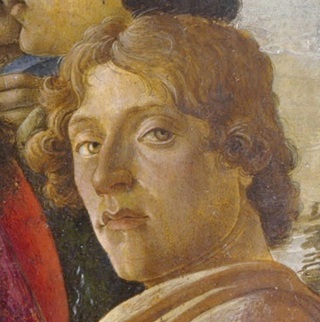How Sandy Little Barrel conquered the artistic world

Sandro Botticelli, La Primavera, The Uffizi Gallery, Florence. Public domain, via Wikimedia Commons.
The life and inspiring works of the artist who gives his name to your room: 3: Sandro Botticelli ***
We’ll bet you’ve never heard of Alessandro di Mariano di Vanni Filipepi. Or Sandy Little Barrel, as his Italian nickname might be translated into English. Neither had we! And yet we’ve named one of our Watermill bedrooms after him.
That’s because he is better known to you and me as Sandro Botticelli.
Even though his paintings date from the second half of the 15th Century, Botticelli’s graceful style is reminiscent of the Early Renaissance. His masterpieces La Primavera (late 1470s/early 1480s) (top above) and The Birth of Venus (1484/6) (below) are among the best-known paintings in the world.

Sandro Botticelli, The Birth of Venus, The Uffizi Gallery, Florence. Public domain, via Wikimedia Commons.
La Primavera, in particular, shows extraordinary attention to detail (below). There are some 500 plant species in the picture, for example, with about 190 flowers, each meticulously and accurately depicted. Floreat Sandro!

Sandro Botticelli, La Primavera, Detail. The Uffizi Gallery, Florence. Public domain, via Wikimedia Commons.
A hidden (in plain sight) self-portrait

Sandro Botticelli, Adoration of the Magi, The Uffizi Gallery, Florence. Public domain, via Wikimedia Commons.
Botticelli was born in Florence in 1445 and died there in 1510. He seldom left the city, apart from a short spell painting in Pisa in 1474, and in Rome, creating three frescoes in the Sistine Chapel in Rome (1481-1482).
As well as his mythological subjects, Botticelli painted many biblical scenes. One, The Adoration of the Magi, (above) contains what is thought to be a self-portrait (right).
Botticelli’s portrait paintings are also exceptional and, in placing the subject in front of a landscape, show how the Italian masters were influenced by Flemish art.

Sandro Botticelli, Portrait of a Man with a Medal of Cosimo the Elder, Uffizi Gallery, Florence. Public domain, via Wikimedia Commons.
*** Who wants a number on the bedroom door when they could be staying in Botticelli, Bronzino or Brunelleschi? Or Gentileschi, Ghirlandaio or Ghiberti? Or one of another half-dozen famous Italian artists, from Alberti to Vasari?
Some years ago we decided to switch from numbers to names in each of our rooms. They celebrate famous Italian artists, mainly from the Renaissance and mainly men, because (a) the early Renaissance is our favourite artistic period and (b) because few women were painting professionally in those days, and even fewer have become famous.
At Lois’ insistence we included Artemesia Gentileschi on our list a few years ago, and in 2026 we are introducing Sofonisba Anguissola, despite her tongue-twisting name.

